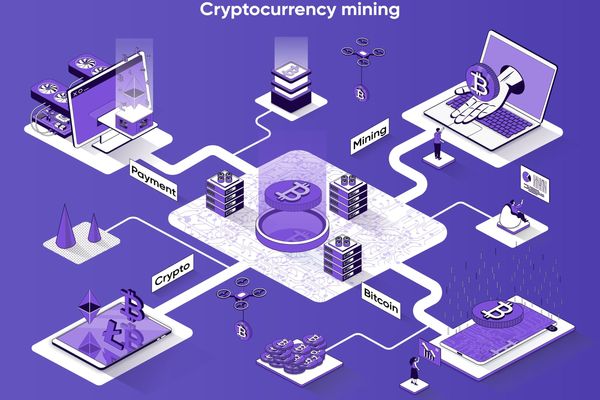Cryptocurrency mining has become a buzzword in recent years, with many individuals and organizations exploring its potential for profit and participation in the decentralized world of digital currencies. This article aims to demystify cryptocurrency mining by breaking down what it entails, how it functions within the blockchain ecosystem, the hardware requirements, and the step-by-step process to embark on your mining journey.
Understanding Cryptocurrency Mining
Cryptocurrency mining is at the core of blockchain technology, serving as the mechanism that validates and records transactions on a distributed ledger. It operates on the principle of proof-of-work (PoW), a consensus algorithm used by numerous cryptocurrencies like Bitcoin and Ethereum. Miners, the participants in this process, play a pivotal role in securing the network by solving complex mathematical puzzles.
How does it work? Miners compete to solve cryptographic puzzles known as “hash puzzles.” These puzzles require miners to discover a unique numeric value, called the “nonce,” that, when combined with the block’s data, generates a hash—a string of characters that meets specific criteria. Typically, this criteria involves having a hash with a certain number of leading zeros. This computational task demands substantial processing power, and miners employ specialized hardware, such as ASICs (Application-Specific Integrated Circuits) or GPUs (Graphics Processing Units), to perform these calculations efficiently. When a miner successfully solves the puzzle, they broadcast their solution to the network for validation, and upon approval, a new block of transactions is added to the blockchain. In return for their efforts, the miner receives cryptocurrency tokens, like Bitcoin, as a reward, thereby incentivizing miners to continue contributing to the network’s security.
How Mining Works
Now that we’ve delved into the essence of cryptocurrency mining, let’s explore the intricacies of how this process operates.
Mining commences when miners initiate the process of solving the cryptographic puzzle, known as the “hash puzzle.” This puzzle is a key element of PoW and entails finding a nonce—a specific numeric value—such that, when combined with the block’s data, results in a hash that satisfies predetermined criteria. Typically, this criteria requires the hash to begin with a certain number of leading zeros. Achieving this involves substantial computational effort, which is why miners utilize specialized hardware tailored to the specific cryptocurrency they intend to mine.
Once a miner successfully solves the hash puzzle, they broadcast their solution to the entire network. The other nodes (participants) in the network then validate the solution to ensure its authenticity and correctness. If the solution checks out, a new block containing a batch of transactions is added to the blockchain. The miner responsible for solving the puzzle is rewarded with cryptocurrency tokens—a motivating factor that encourages miners to continue contributing to the network’s security and maintaining its integrity.
Getting Started with Cryptocurrency Mining
With a foundational understanding of cryptocurrency mining in place, let’s move forward and discuss how you can embark on your mining journey.
1. Choose Your Cryptocurrency
The initial step in cryptocurrency mining involves selecting the specific digital currency you wish to mine. When making this choice, consider various factors such as the mining equipment you have, the cost of electricity in your location, and the potential profitability of mining that particular cryptocurrency. While Bitcoin and Ethereum are well-known options, there is an extensive list of cryptocurrencies to explore.
2. Obtain the Necessary Hardware
Efficient cryptocurrency mining requires suitable hardware tailored to your chosen cryptocurrency. ASIC miners are ideal for Bitcoin, whereas GPUs offer versatility and can be employed for mining various cryptocurrencies. To optimize your mining efficiency, invest in high-quality, energy-efficient equipment.
3. Set Up a Wallet
Prior to commencing mining operations, you need a secure wallet to store the cryptocurrency tokens you’ll earn. Different types of wallets are available, including hardware wallets, software wallets, and online wallets. For long-term storage and enhanced security, hardware wallets are the preferred choice.
4. Choose a Mining Pool
Mining independently can be challenging, particularly for newcomers, as it may take a substantial amount of time to receive rewards. To increase your chances of successfully solving blocks and earning rewards, consider joining a mining pool. Numerous mining pools catering to different cryptocurrencies can be found online, each with its unique characteristics.
5. Install Mining Software
Once you’ve secured your hardware and selected a mining pool, the next step is to install mining software. This software facilitates communication between your mining rig and the pool, providing the necessary instructions for mining. An array of mining software options is available, catering to different hardware configurations and cryptocurrency preferences.
6. Start Mining
With all the components in place, you are ready to commence mining by running your chosen mining software. Be prepared for a degree of trial and error as you fine-tune settings to achieve optimal performance. Monitor your mining progress, and over time, you should begin to witness cryptocurrency rewards accumulating in your wallet.
Conclusion
Cryptocurrency mining is a captivating and potentially profitable pursuit that has garnered substantial attention in recent years. While it may appear complex initially, with the right knowledge and equipment, anyone can embark on a journey into the world of cryptocurrency mining. Ensure you make an informed choice regarding your cryptocurrency, invest in suitable hardware, and stay informed about the latest developments in the cryptocurrency mining landscape. As your experience grows, you can explore more advanced mining strategies and potentially transform your mining endeavor into a rewarding, long-term venture. Happy mining!
FAQ’s
Cryptocurrency mining validates transactions on a blockchain through proof-of-work (PoW), where miners solve complex mathematical puzzles to add new blocks to the chain. Successful miners are rewarded with cryptocurrency tokens.
Choose a cryptocurrency, obtain suitable hardware, set up a secure wallet, join a mining pool for better rewards, install mining software, and start mining. Monitor progress and adjust settings for optimal performance.
Mining pools increase the likelihood of successfully solving blocks and receiving rewards by combining the computational power of multiple miners. Joining a pool is particularly beneficial for beginners, as it accelerates the reward-earning process.

